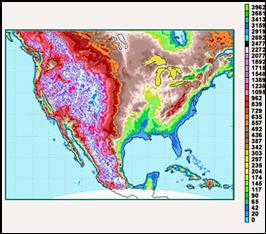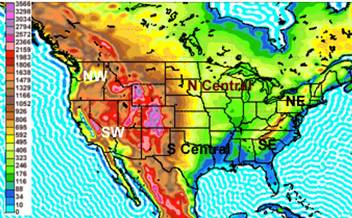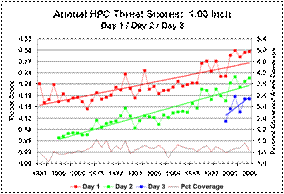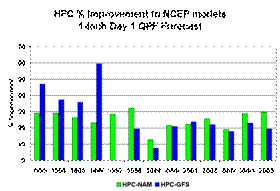|
†Heavy precipitation forecasting,† using numerical models. |
|
Despite significant increases in computing power and increase resolution of operational models,† improvements in the accuracy of quantitative precipitation forecasts has been slow.† There are a number of factors that can contribute to operation models producing forecast errors.†
1) there may not be enough data to resolve features.† This is especially true over data sparse areas and the oceans.† Moisture and temperature derived from satellite data may not have the desired vertical resolution. 2) Some physical processes operate at a scale below that of the resolution of the models so they need to be parameterized. Essentially,† physical representations of the effects of these processes need to developed.†† Radiation, convection, boundary layer processes, evapo-transpiration and within cloud microphysical are some of the processes that are currently parameterized in the operational models.† Any shortcoming of a parameterization scheme can adversely impact the forecast which may lead to a poor precipitation forecast.†† However,†† one parameterization scheme can impact on another.† 3) Atmospheric processes are non-linear meaning that small differences in the initial condition can lead to significant differences in a forecast. Also,† two models with different convective schemes may produce different precipitation forecasts and the latest heat release from the condensation may feed back into the mass and wind field forecasts with time.†† The non-linear response to atmospheric forcing and the chaos it engenders is the reason for the development of ensemble forecast systems.† 4) The current generation of operation models may not have enough resolution to resolve some features.† |


|
GFS T382 Orography |
|
Why models have forecasting Problems |


|
There has been a steady improvement in the accuracy of HPC quantitative precipitation forecasts since the 1960s.† Much of that improvement is directly attributable increases in the vertical and horizontal resolution,† improvements in data assimilation and model physics which have led to better mass and wind field forecasts and improved forecasts of quantitative precipitation.† Despite these improvements, HPC forecasters have been able to improve model forecasts.† |
|
The discussion that follows will be an attempt to provide forecasters with tools to improve and modify the modelsí QPF.††† Before attempting to make precipitation forecast,† it is important to understand why models sometimes have problems during a forecast and to understand some of their biases.††† The sections that follow with attempt to explain: 1) why there is uncertainty in any model forecasts, 2) briefly discuss the operational NCEP models and their recent performance characteristics (as of winter 2007), 3)† briefly discuss ensemble forecasting, 4) offer examples of how ensemble guidance can be used to predict extreme rainfall events.† |
|
No model not matter what the resolution will have a perfect deterministic solution.† There is always uncertainty.† However,† the amount of uncertainty differs depending on the pattern.† Ensemble forecasts systems can help quantify this uncertainty.† |